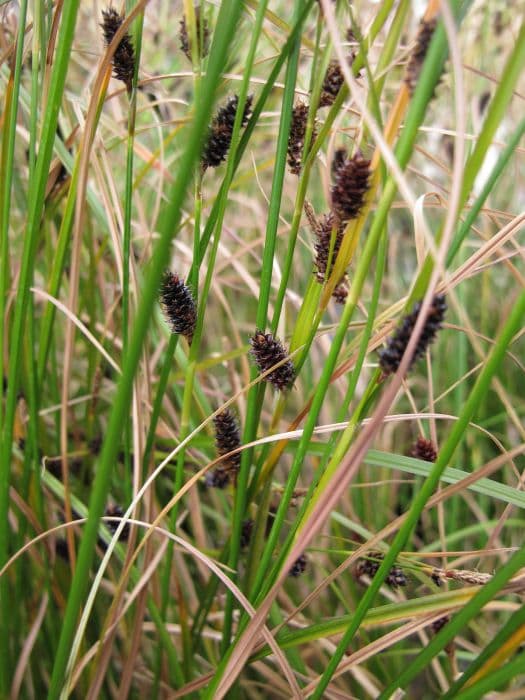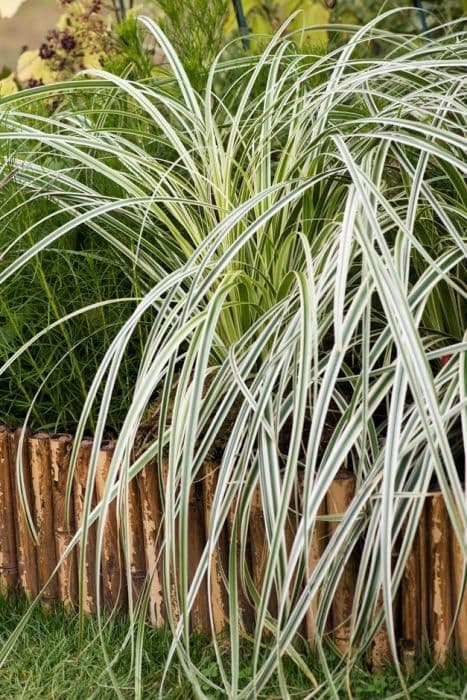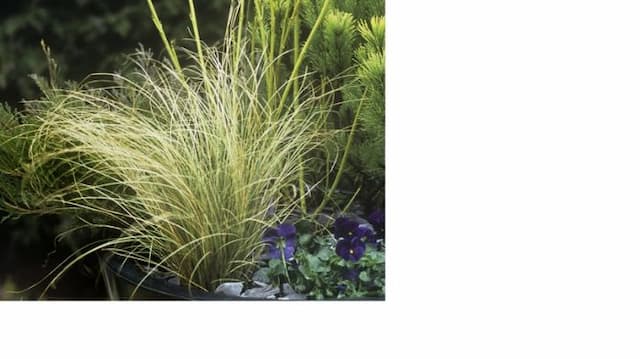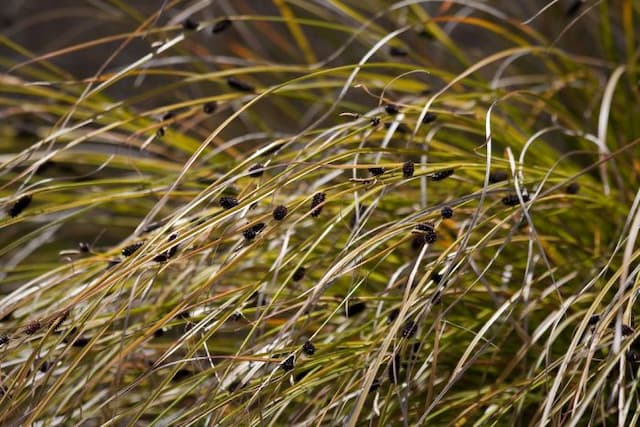Sparkler Sedge Carex phyllocephala 'Sparkler' (v)

ABOUT
The Sparkler Sedge is a visually striking ornamental grass known for its exotic and vibrant appearance. The plant displays a fountain-like clump of foliage that seems to burst outward in all directions, giving it a full and rich texture. The leaves of this exotic grass are thin and variegated, featuring stripes of white and green that run parallel along the length of each blade. This variegation creates a striking contrast and adds brightness to shaded areas in the garden. Moreover, the Sparkler Sedge has a unique characteristic where the tips of the leaves branch out, resembling the sparklers one might see during festive celebrations, hence the name 'Sparkler'. This gives the plant a whimsical and lively feel, as the thin leaf strands seem to dance atop the main body of foliage. The overall impression of the Sparkler Sedge is one of lightness and festivity, making it a delightful addition to both container gardens and garden beds where a touch of flair is desired.
About this plant
 Names
NamesFamily
Cyperaceae
Synonyms
Sparkler Sedge, Sparkler Palm Sedge, Variegated Palm Sedge
Common names
Carex phyllocephala 'Sparkler'.
 Toxicity
ToxicityTo humans
The Sparkler sedge is not commonly listed as a toxic plant for humans. However, as with any plant not intended for consumption, it could potentially cause irritation or a mild stomach upset if ingested. It is always best to exercise caution and keep plants out of reach of children, who might be tempted to eat them, and to consult a medical professional if ingestion occurs and any adverse reactions are noticed.
To pets
The Sparkler sedge does not have a widespread reputation for being toxic to pets. Nevertheless, pet owners should exercise caution, as individual animals may react differently to ingesting plant material. If a pet ingests part of the plant and shows symptoms such as vomiting, diarrhea, or other signs of distress, it is important to consult a veterinarian. It is generally good practice to prevent pets from eating ornamental plants to avoid any potential issues.
 Characteristics
CharacteristicsLife cycle
Perennials
Foliage type
Evergreen
Color of leaves
Variegated
Height
1-2 feet (30-60 cm)
Spread
1-2 feet (30-60 cm)
Plant type
Sedge
Hardiness zones
7
Native area
Asia
Benefits
 General Benefits
General Benefits- Visual Interest: The Carex phyllocephala 'Sparkler' (Sparkler sedge) offers distinctive foliage that adds a unique aesthetic appeal to gardens and landscapes.
- Low Maintenance: Sparkler sedge is known for its ease of care, requiring minimal upkeep once established.
- Drought Tolerance: This plant is relatively drought-tolerant, making it suitable for xeriscaping and water-conserving gardens.
- Soil Erosion Control: Its dense growth habit helps prevent soil erosion, especially on slopes and in areas prone to water runoff.
- Versatility: It can be used in a variety of landscaping designs, including containers, borders, and as ground cover.
- Adaptability: Sparkler sedge adapts well to a range of soil types, though it prefers well-draining soil.
- Wildlife Attraction: While not its primary benefit, Sparkler sedge can provide shelter and nesting material for small wildlife and insects.
- Texture Contrast: The plant’s spiky, variegated leaves add contrast when placed among plants with different textures.
- Seasonal Interest: Provides year-round interest due to its evergreen nature in milder climates and perennial growth habit.
- Cold Hardy: It is relatively cold hardy, making it suitable for growing in a variety of climates with appropriate winter care.
 Medical Properties
Medical PropertiesThis plant is not used for medical purposes.
 Air-purifying Qualities
Air-purifying QualitiesThis plant is not specifically known for air purifying qualities.
 Other Uses
Other Uses- Accent in floral arrangements: The 'Sparkler' Sedge's variegated foliage can add unique texture and color to cut flower arrangements.
- Container gardening: This plant is suitable for growing in containers where its striking leaves can be appreciated up close.
- Bonsai: With careful pruning, the 'Sparkler' Sedge can be trained into a bonsai form for enthusiasts of miniature landscapes.
- Erosion control: When planted en masse, its root system can help stabilize soil on slopes or in areas prone to erosion.
- Craft projects: Dried leaves of the plant can be used in craft projects, such as making bookmarks or in scrapbooking.
- Photography subject: Its unique appearance makes it an interesting subject for botanical photographers.
- Living mulch: When planted densely, it can act as a living mulch, suppressing weeds and retaining soil moisture.
- Edge Borders: Perfect for creating defined edges along pathways and garden borders due to its clumping nature.
- Fairy gardens: Its small size and ornamental leaves make it an ideal plant for creating magical fairy garden landscapes.
- Outdoor art installations: 'Sparkler' Sedge can be creatively used in outdoor art installations for its structural form and color.
Interesting Facts
 Feng Shui
Feng ShuiThe Sparkler sedge is not used in Feng Shui practice.
 Zodiac Sign Compitability
Zodiac Sign CompitabilityThe Sparkler sedge is not used in astrology practice.
 Plant Symbolism
Plant Symbolism- Vitality: The bright and sparkling variegation of Sparkler Sedge gives the impression of energy and liveliness, symbolizing the vigor and dynamism of life.
- Resilience: As a hardy plant that can thrive in various conditions, Sparkler Sedge represents the ability to endure and adapt to different environments and circumstances.
- Balance: The grass-like structure of Sparkler Sedge, with its arching leaves, imbues it with a sense of equilibrium, suggesting the importance of maintaining balance in one’s life.
- Flexibility: The long, slender leaves that move with the wind can symbolize flexibility and the grace to bend without breaking in the face of adversity.
 Water
WaterThe Sparkler Sedge prefers consistently moist soil, so it should be watered thoroughly when the top inch of soil feels dry to the touch. Depending on the environmental conditions, this might be once every 5 to 7 days. It's important not to let the soil dry out completely, but also to avoid waterlogging as this can lead to root rot. During the active growing season in spring and summer, you might find the need to water more frequently, especially if the plant is outside in warmer temperatures. Aim to provide about one gallon of water per week, adjusting as needed based on rainfall and temperature.
 Light
LightSparkler Sedge thrives in partial shade to full shade conditions. The best spot for this plant would be an area that receives filtered sunlight or a location with morning sun and afternoon shade. Bright, indirect light is ideal as too much direct sunlight can scorch the leaves, while too little light may hinder its growth and vibrant leaf coloring.
 Temperature
TemperatureSparkler Sedge does well in temperatures ranging from 60 to 75 degrees Fahrenheit but can tolerate minimum temperatures down to about 50 degrees Fahrenheit and maximum temperatures up to around 85 degrees Fahrenheit. Avoid exposure to temperatures outside of this range for prolonged periods, as extreme cold can damage the foliage, and excessive heat may stress the plant.
 Pruning
PruningPruning Sparkler Sedge is mainly for aesthetic purposes, to remove brown or damaged leaves and to maintain the shape of the plant. It's best done in late winter or early spring before new growth begins. Lightly prune or comb out any dead foliage with your fingers or a small rake annually to keep the plant looking its best.
 Cleaning
CleaningAs needed
 Soil
SoilSparkler Sedge (most common name) thrives best in a well-drained, moist potting mix with a pH of 5.5 to 6.5. A mixture of equal parts peat, perlite, and loamy soil is ideal, providing adequate drainage and nutrient retention.
 Repotting
RepottingSparkler Sedge should be repotted every 2-3 years or when it outgrows its current pot. It's best to repot in spring or early summer.
 Humidity & Misting
Humidity & MistingSparkler Sedge prefers moderate to high humidity levels; aim for a humidity range of 50-70% for optimal growth.
 Suitable locations
Suitable locationsIndoor
Place Sparkler Sedge in bright, indirect light, avoiding direct sun.
Outdoor
Plant in partial shade; protect from harsh sun.
Hardiness zone
7-10 USDA
 Life cycle
Life cycleCarex phyllocephala 'Sparkler', commonly known as Sparkler Sedge, begins its life cycle when seeds germinate in late winter to early spring, given appropriate moisture and temperature conditions. After germination, seedlings establish a root system and begin to produce distinctively variegated foliage that forms a tufted mound. Throughout the spring and summer, the plant focuses on vegetative growth, developing its clump-forming habit with more foliage and strengthening its root system. Some mature plants may produce small, inconspicuous flowers and subsequently seeds by late summer or early fall, allowing for self-propagation. During the fall, growth slows and the plant enters a period of dormancy in colder climates, where foliage may die back at the soil line with the onset of freezing temperatures. With the return of warmer weather in spring, Sparkler Sedge resumes growth from its rootstock, repeating its annual life cycle.
 Propogation
PropogationPropogation time
Spring-Early Summer
Propogation: The most popular method of propagating Carex phyllocephala 'Sparkler', commonly known as Sparkler Sedge, is by division. The ideal time to propagate Sparkler Sedge by division is in the spring, when the plant is emerging from dormancy and the root system is actively developing. To propagate, carefully dig up the parent plant, ensuring a good amount of roots are attached. Gently separate the plant into smaller sections, each with a clump of roots and several growing points. Replant the divisions at the same depth they were growing previously, spacing them approximately 12 inches (about 30 centimeters) apart to allow for growth. Water the new plantings well to help establish the roots in their new locations. This straightforward method allows gardeners to quickly increase their stock of Sparkler Sedge while preserving the health and vigor of the parent plant.









